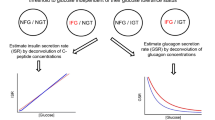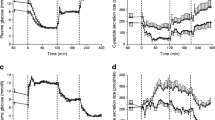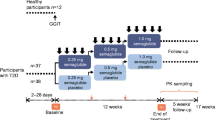Abstract
In young healthy individuals, an i.v. glucose bolus leads to an immediate increase in plasma insulin, whereas in non-insulin-dependent diabetic patients this early response is diminished, lacking or even negative. In the present study, we sought to determine whether negative responses were also present during square-wave glucose stimulation (transition from 18 to 25 mM), whether they represented a decrease in beta-cell secretion, whether they were accompanied by an altered response to arginine (5 gl-arginine bolus), and whether they were a consequence of ageing rather than of diabetes. A group of 12 patients (aged 53±2 years, mean±SE) with non-insulin-dependent diabetes (D) and 12 matched healthy controls (C; aged 47±1 years) were evaluated twice at an interval of 3 months. Other baseline values were body mass index (BMI) 28±1 (D) and 26±1 (C) kg/m2, fasting C-peptide 0.85±0.12 (D) and 0.92±0.10(C) nmol/l, and fasting P-glucose 12.3±0.9 (D) and 5.8±0.1 (C) mM,P<0.05. Paradoxical responses (a decrease of two or more times the SD of the analysis within 15 min of increasing the glucose concentration) were seen in five diabetic patients for insulin (22±8%) and in nine diabetic patients for C-peptide (13±3%), but never in the healthy controls. Plasma glucose increased and protein decreased similarly, whether the responses were paradoxical or not. Paradoxial responses were reproduced after three months. Responses to arginine did not correlate with responses to glucose. In summary, in contrast to healthy matched controls, 40–75% of non-insulin-dependent diabetics show a marked initial decrease in beta-cell secretion upon square-wave glucose stimulation. This is probably specific to glucose stimulation, as it did not occur in response to arginine stimulation.
Similar content being viewed by others
References
Simpson RG, Benedetti A, Grodsky GM, Karam JH, Forsham PH, Early phase of insulin release. Diabetes 17:684–692, 1968
Ward KW, Bolgiano DC, McKnight B, Halter JB, Porte D, Diminished β-cell secretory capacity in patients with non-insulin dependent diabetes mellitus. J Clin Invest 74:1318–1328, 1984
Metz SA, Halter JB, Robertson RP, Paradoxical inhibition of insulin secretion by glucose in human diabetes mellitus. J Clin Endocrinol Metab 48:827–835, 1979
Soneru IL, Hein N, Jeffery JD, Abraira C, Recovery of staub effect and amelioration of insulin secretion defects after glyburide treatment in non-insulin dependent diabetics. Diabetes Res 15:77–83, 1990
Glaser B, Liebovich G, Nesher R, Hartling S, Binder C, Cerasi E, Improved beta-cell function after intensive insulin treatment in severe non-insulin dependent diabetes. Acta Endocrinol 118:365–373, 1988
Lerner RL, Porte D, Acute and steady state insulin responses to glucose in nonobese diabetic subjects. J Clin Invest 51:1624–1631, 1972
Novials A, Gomis R, Coves MJ, Conget I, Malaisse WJ, Improvement by insulin treatment of the early phase of glucose stimulated insulin release in non-insulin dependent diabetics explored after restoration of hyperglycaemia. Med Sci Res 17:381–392, 1989
Gomis R, Plaza C, Malaisse WJ, Diazoxide-induced long term hyperglycaemia. I.Preservation of β-cell insulin-releasing capacity. Diabetes Res 9:183–186, 1988
Gjessing HJ, C-peptide used in the estimation of islet beta-cell function in diabetics. Dan Med Bull 39:438–452, 1992
Ferner RE, Ashworth L, Tronier B, Alberti KGMM, Effects of short-term hyperglycaemia on insulin secretion in normal humans. Am J Physiol 250:E655–661, 1986
DeFronzo RA, Tobin JD, Andres R, Glucose clamp technique: a method for quantifying insulin secretion and resistance. Am J Physiol 237: E214–223, 1979
Mikines KJ, Farrell PA, Sonne B, Tronier B, Galbo H, Post-exercise dose-response relationship between plasma glucose and insulin secretion. J Appl Physiol 64:988–999, 1988
Mikines KJ, Sonne B, Farrell PA, Tronier B, Galbo H, Effects of physical exercise on sensitivity and responsiveness to insulin in humans. Am J Physiol 254:E248–258, 1988
Ravanam A, Jeffery J, Nehlawi M, Abraira C, Improvement of glucose primed intravenous glucose tolerance and correction of acute insulin decrement by glipizide in type 2 diabetes. Metabolism 40:1173–1177, 1991
Hollander PM, Asplin CM, Palmer JP, Glucose modulation of insulin and glucagon secretion in nondiabetic and diabetic man. Diabetes 31:489–495, 1982
Hosker JP, Rudenski AS, Burnett MA, Matthews DR, Turner RC, Similar reduction of first- and second-phase β-cell responses at three different glucose levels in type II diabetes and the effect of gliclazide therapy. Metabolism 38:767–772, 1989
Pagano G, Lombardi A, Pisu E, Bozzo C, Masciola P, Ferraris GM, Bruno A, Hyperglycaemic clamp and insulin binding to isolated monocytes before and after glibenclamide treatment of mild type II diabetics. Horm Metabol Res 16:215–220, 1984
Hoenig M, Macgregor LC, Matchinsky FM, In vitro exhaustion of pancreas beta cells. Am J Physiol 250:E502–E511, 1986
Polonsky KS, Rubenstein AH, C-peptide as a measure of the secretion and hepatic extraction of insulin. Diabetes 33:486–494, 1984
Faber OK, Hagen C, Binder C, Kinetics of human connecting peptide in normal and diabetic subjects. J Clin Invest 62:197–203, 1978
Polonsky KS, Given BD, Hirsh L, Shapiro ET, Tillil H, Beebe C, Galloway JA, Frank BH, Karrison T, Van Cauter E, Quantitative study of insulin secretion and clearance in normal and obese subjects. J Clin Invest 81:435–411, 1988
Hedeskov CJ, Mechanism of glucose-induced insulin secretion. Physiol Rev 60:442–509, 1980
Hermans MP, Schmeer W, Henquin JC, The permissive effect of glucose, tolbutamide and high K+ on arginine stimulation of insulin release in isolated mouse islets. Diabetologia 30:659–665, 1987
Porte D, Beta-cells in type 2 diabetics. Diabetes 40:166–180, 1991
Tsuchiyama S, Tanigawa K, Kato Y, Effect of ageing on the sensitivity of pancreatic beta-cells to insulin secretagogues in rats. Endocrinol Japan 38:551–557, 1991
Tsuji K, Taminato T, Ishida H, Okamoto Y, Tsuura Y, Kato S, Kurose T, Okada Y, Imura H, Seino Y, Selective impairment of the cytoplasmic Ca2+ response to glucose in pancreatic beta-cells of streptozocin-induced non-insulin-dependent diabetic rats. Metabolism 42:1424–1428, 1993
Blachier F, Mourtada A, Sener A, Malaisse WJ, Stimulus-secretion coupling of arginine-induced insulin release. Uptake of metabolized and nonmetabolized cationic amino acids by pancreatic islets. Endocrinology 124:134–414, 1989
Hellman B, Calcium transport in pancreatic beta-cells:implications for glucose regulation of insulin release. Diabetes/Metabolism Reviews 2:215–241, 1986
Pollack ML, Schmidt DH, Measurement of cardio-respiratory fitness and body composition in the clinical setting. Compr Therapy 6:12–27, 1980
Author information
Authors and Affiliations
Rights and permissions
About this article
Cite this article
Linstow, M., Mikines, K.J., Dela, F. et al. Paradoxical inhibition of insulin secretion by glucose in non-insulin-dependent diabetic patients. Acta Diabetol 32, 1–6 (1995). https://doi.org/10.1007/BF00581036
Received:
Accepted:
Issue Date:
DOI: https://doi.org/10.1007/BF00581036




